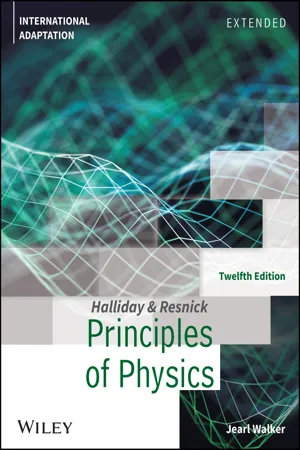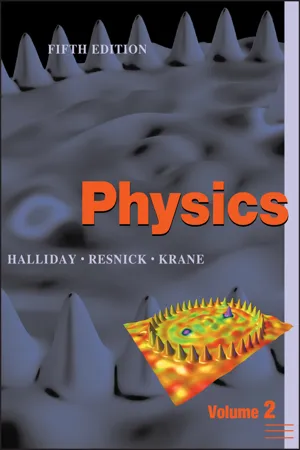Physics
Electric Potential
Electric potential is a scalar quantity that represents the potential energy per unit charge at a specific point in an electric field. It is measured in volts and is a fundamental concept in understanding the behavior of electric charges and electric fields. The electric potential at a point is the work done per unit charge in bringing a positive test charge from infinity to that point.
Written by Perlego with AI-assistance
Related key terms
1 of 5
12 Key excerpts on "Electric Potential"
- eBook - ePub
- A. L. Stanford, J. M. Tanner(Authors)
- 2014(Publication Date)
- Academic Press(Publisher)
13Electric Potential
Publisher Summary
This chapter discusses Electric Potential. Electric fields are vector fields that have both magnitude and direction at every point at which the field is defined. The electrical properties of space can also be described by Electric Potential, which is, in some respects, a simpler and more practical concept than the electric field. Electric Potential is simpler than electric fields because Electric Potential is a scalar quantity and, therefore, has no direction associated with it. Electric Potential is more practical than the electric field because differences in potential, at least on conductors, are more readily measured directly. Electric Potentials and electric fields in a given region are related to each other, and either can be used to describe the electrostatic properties of space. The gravitational potential energy of an object at a point is meaningful only in terms of the difference in potential energy between that point and the potential energy specified at some reference point. Electric Potential should have characteristics similar to those of gravitational potential energy for Electric Potential to be equally useful.We have stressed that electric fields are a means of characterizing a physical property of space caused by the presence of electrostatic charge. Electric fields are vector fields that have both magnitude and direction at every point at which the field is defined. The electrical properties of space can also be described by Electric Potential, which is, in some respects, a simpler and more practical concept than the electric field. Electric Potential is simpler than electric fields because Electric Potential is a scalar quantity and, therefore, has no direction associated with it. Electric Potential is more practical than the electric field because differences in potential, at least on conductors, are more readily measured directly. - eBook - PDF
- David Halliday, Robert Resnick, Jearl Walker(Authors)
- 2020(Publication Date)
- Wiley(Publisher)
Repeating this procedure we find that an Electric Potential is set up at every point in the rod’s electric field. In fact, every charged object sets up Electric Potential V at points throughout its electric field. If we happen to place a particle with, say, charge q at a point where we know the pre-existing V, we can immedi- ately find the potential energy of the configuration: (Electric Potential energy) = (particle’s charge) ( Electric Potential energy unit charge ) , or U = qV, (24-3) where q can be positive or negative. Two Cautions. (1) The (now very old) decision to call V a potential was unfortunate because the term is easily confused with potential energy. Yes, the two quantities are related (that is the point here) but they are very different and not interchangeable. (2) Electric Potential is a scalar, not a vector. (When you come to the homework problems, you will rejoice on this point.) Language. A potential energy is a property of a system (or configuration) of objects, but sometimes we can get away with assigning it to a single object. For example, the gravitational potential energy of a baseball hit to outfield is actually a potential energy of the baseball–Earth system (because it is associ- ated with the force between the baseball and Earth). However, because only the baseball noticeably moves (its motion does not noticeably affect Earth), we might assign the gravitational potential energy to it alone. In a similar way, if a charged particle is placed in an electric field and has no noticeable effect on the field (or the charged object that sets up the field), we usually assign the Electric Potential energy to the particle alone. Units. The SI unit for potential that follows from Eq. 24-2 is the joule per coulomb. This combination occurs so often that a special unit, the volt (abbrevi- ated V), is used to represent it. - eBook - PDF
- William Moebs, Samuel J. Ling, Jeff Sanny(Authors)
- 2016(Publication Date)
- Openstax(Publisher)
(The default assumption in the absence of other information is that the test charge is positive.) We briefly defined a field for gravity, but gravity is always attractive, whereas the electric force can be either attractive or repulsive. Therefore, although potential energy is perfectly adequate in a gravitational system, it is convenient to define a quantity that allows us to calculate the work on a charge independent of the magnitude of the charge. Calculating the work directly may be difficult, since W = F → · d → and the direction and magnitude of F → can be complex for multiple charges, for odd-shaped objects, and along arbitrary paths. But we do know that because F → = q E → , the work, and hence ΔU, is proportional to the test charge q. To have a physical quantity that is independent of test charge, we define Electric Potential V (or simply potential, since electric is understood) to be the potential energy per unit charge: Electric Potential The Electric Potential energy per unit charge is (7.4) V = U q . Since U is proportional to q, the dependence on q cancels. Thus, V does not depend on q. The change in potential energy ΔU is crucial, so we are concerned with the difference in potential or potential difference ΔV between two points, where Chapter 7 | Electric Potential 293 ΔV = V B − V A = ΔU q . Electric Potential Difference The Electric Potential difference between points A and B, V B − V A , is defined to be the change in potential energy of a charge q moved from A to B, divided by the charge. Units of potential difference are joules per coulomb, given the name volt (V) after Alessandro Volta. 1 V = 1 J/C The familiar term voltage is the common name for Electric Potential difference. Keep in mind that whenever a voltage is quoted, it is understood to be the potential difference between two points. For example, every battery has two terminals, and its voltage is the potential difference between them. - David Halliday, Robert Resnick, Jearl Walker(Authors)
- 2023(Publication Date)
- Wiley(Publisher)
Two Cautions. (1) The (now very old) decision to call V a potential was unfortunate because the term is easily confused with potential energy. Yes, the two quantities are related (that is the point here) but they are very different and not interchangeable. (2) Electric Potential is a scalar, not a vector. (When you come to the homework problems, you will rejoice on this point.) Language. A potential energy is a property of a system (or configuration) of objects, but sometimes we can get away with assigning it to a single object. For example, the gravitational potential energy of a baseball hit to outfield is actually a potential energy of the baseball–Earth system (because it is associated with the force between the baseball and Earth). However, because only the baseball notice- ably moves (its motion does not noticeably affect Earth), we might assign the gravi- tational potential energy to it alone. In a similar way, if a charged particle is placed in an electric field and has no noticeable effect on the field (or the charged object that sets up the field), we usually assign the Electric Potential energy to the particle alone. Units. The SI unit for potential that follows from Eq. 24.1.2 is the joule per coulomb. This combination occurs so often that a special unit, the volt (abbrevi- ated V), is used to represent it. Thus, 1 volt = 1 joule per coulomb. With two unit conversions, we can now switch the unit for electric field from newtons per coulomb to a more conventional unit: 1 N/C = ( 1 N __ C ) ( 1 V _____ 1 J / C ) ( 1 J _______ 1 N ⋅ m ) = 1 V / m. The conversion factor in the second set of parentheses comes from our definition of volt given above; that in the third set of parentheses is derived from the defini- tion of the joule. From now on, we shall express values of the electric field in volts per meter rather than in newtons per coulomb. Motion Through an Electric Field Change in Electric Potential.- eBook - PDF
- Michael Tammaro(Author)
- 2019(Publication Date)
- Wiley(Publisher)
For brevity, Electric Potential may be referred to simply as potential. Electric Potential, like potential energy, is a scalar quantity, so it has no direction. The SI unit of potential is joules per coulomb (J/C), which is called a volt (V), so = 1 J C 1 V / . Equation 19.1.2 defines only the change in potential and applies only when the electric field is uniform. Example 19.1.1 illustrates the use of Equation 19.1.2. Example 19.1.1 Electric Field and Electric Potential The Electric Potential is 32.3 V at point ( ) 12.2 cm, 0.0 cm of an x–y coordinate system. A uniform electric field has a magnitude of 49.4 N C / and is in the negative x direction. (a) What is the value of the Electric Potential at ( ) 12.2 cm, 26.9 cm ? (b) What is the value of the Electric Potential at ( ) 38.4 cm, 26.9 cm ? 518 | Chapter 19 Identify Electric Potential is measured in volts (V), where = 1 V 1 J C / . The diagram illustrates the situation, including an arrow to represent the electric field and the three points of interest, labeled A, B, and C. +x +y B: (12.2 cm, 26.9 cm) C: (38.4 cm, 26.9 cm) A: (12.2 cm, 0.0 cm) E The electric field points in the negative x direction. For the purposes of calculating s ∆ in Equations 19.1.1 or 19.1.2, take the positive s direction to be in the direction of the electric field. Plan (a) Use Equation 19.1.2 to determine the Electric Potential difference between points A and B. The potential at B is equal to the potential at A plus the potential difference between A and B. (b) Apply the strategy from part (a) to points B and C. Solve Let V 32.3 V A = , V B , and V C be the values of the Electric Potential at points A, B, and C, respectively. (a) To calculate V V V B A ∆ = − , we multiply the magnitude of the electric field E by ∆s, which is the component of the displacement from A to B that is in the direction of E —that is, the negative x direction. The displacement from A to B, however, is in the positive y direction, so s 0 ∆ = . - eBook - PDF
- John D. Cutnell, Kenneth W. Johnson, David Young, Shane Stadler(Authors)
- 2018(Publication Date)
- Wiley(Publisher)
The quantity EPE/q 0 is the Electric Potential energy per unit charge and is an important concept in electricity. It is called the Electric Potential or, simply, the potential and is referred to with the symbol V, as in Equation 19.3. DEFINITION OF Electric Potential The Electric Potential V at a given point is the Electric Potential energy EPE of a small test charge q 0 situated at that point divided by the charge itself: V = EPE q 0 (19.3) SI Unit of Electric Potential: joule/coulomb = volt (V) The SI unit of Electric Potential is a joule per coulomb, a quantity known as a volt. The name honors Alessandro Volta (1745–1827), who invented the voltaic pile, the forerunner of the battery. In spite of the similarity in names, the Electric Potential energy EPE and the Electric Potential V are not the same. The Electric Potential energy, as its name implies, is an energy and, therefore, is measured in joules. In contrast, the Electric Potential is an energy per unit charge and is measured in joules per coulomb, or volts. Initial gravitational, potential energy, GPE A { Final gravitational potential energy, GPE B { h A F = mg F = mg h B A B FIGURE 19.1 Gravity exerts a force, F → = m g → , on the basketball of mass m. Work is done by the gravitational force as the ball falls from A to B. q 0 F = q 0 E q 0 F = q 0 E A B − − − − − − − − − − − − − − + + + + + + + + + + + + + + INTERACTIVE FIGURE 19.2 Because of the electric field E → , an electric force, F → = q 0 E → , is exerted on a positive test charge +q 0 . Work is done by the force as the charge moves from A to B. 19.2 The Electric Potential Difference 525 We can now relate the work W AB done by the electric force when a charge q 0 moves from A to B to the potential difference V B − V A between the points. - eBook - PDF
- John D. Cutnell, Kenneth W. Johnson, David Young, Shane Stadler(Authors)
- 2021(Publication Date)
- Wiley(Publisher)
578 CHAPTER 19 Electric Potential Energy and the Electric Potential 19.1 Potential Energy In Chapter 18 we discussed the electrostatic force that two point charges exert on each other, the magnitude of which is F = k∣q 1 ∣∣q 2 ∣/r 2 . The form of this equation is similar to the form for the gravitational force that two particles exert on each other, which is F = Gm 1 m 2 /r 2 , according to Newton’s law of universal gravitation (see Section 4.7). Both of these forces are conservative and, as Section 6.4 explains, a potential energy can be associated with a conservative force. Thus, an Electric Potential energy exists that is analogous to the gravitational potential energy. To Lightning permeates the sky around the ash plume above the Puyehue-Cordon Caulle volcano in south-central Chile in 2011. Unlike normal lightning associated with rain clouds, where static charges are produced by colliding ice particles, volcanic lightning, or “dirty thunderstorms,” can result from frictional charging between colliding ash and dust particles. The natural convective thermal currents in the hot ash cloud aid in the separation of charges. This creates extremely high differences in voltage, or potential, between different parts of the dust cloud or between the cloud and the ground. If the voltage difference is sufficiently large, the insulating properties of the air break down, and it conducts electricity in spectacular fashion. The Electric Potential, and its relationship to charge, will be one of the topics we study in this chapter. Carlos Gutierrez/Reuters LEARNING OBJECTIVES After reading this module, you should be able to... 19.1 Define electrical potential energy. 19.2 Solve problems involving Electric Potential and Electric Potential energy. 19.3 Calculate Electric Potential created by point charges. 19.4 Relate equipotential surfaces to the electric field. 19.5 Solve problems involving capacitors. 19.6 Describe biomedical applications of Electric Potential. - eBook - PDF
- John D. Cutnell, Kenneth W. Johnson, David Young, Shane Stadler(Authors)
- 2015(Publication Date)
- Wiley(Publisher)
The quantity EPE/q 0 is the Electric Potential energy per unit charge and is an important concept in electricity. It is called the Electric Potential or, simply, the potential and is referred to with the symbol V, as in Equation 19.3. Definition of Electric Potential The Electric Potential V at a given point is the Electric Potential energy EPE of a small test charge q 0 situated at that point divided by the charge itself: V 5 EPE q 0 (19.3) SI Unit of Electric Potential: joule/coulomb 5 volt (V) The SI unit of Electric Potential is a joule per coulomb, a quantity known as a volt. The name honors Alessandro Volta (1745–1827), who invented the voltaic pile, the forerunner of the battery. In spite of the similarity in names, the Electric Potential energy EPE and the Electric Potential V are not the same. The Electric Potential energy, as its name implies, is an energy and, therefore, is measured in joules. In contrast, the Electric Potential is an energy per unit charge and is measured in joules per coulomb, or volts. We can now relate the work W AB done by the electric force when a charge q 0 moves from A to B to the potential difference V B 2 V A between the points. Combining Equations 19.2 and 19.3, we have: V B 2 V A 5 EPE B q 0 2 EPE A q 0 5 2W AB q 0 (19.4) Often, the “delta” notation is used to express the difference (final value minus initial value) in potentials and in potential energies: DV 5 V B 2 V A and D(EPE) 5 EPE B 2 EPE A . In terms of this notation, Equation 19.4 takes the following more compact form: DV 5 D (EPE) q 0 5 2W AB q 0 (19.4) q 0 F = q 0 E q 0 F = q 0 E A B − − − − − − − − − − − − − − + + + + + + + + + + + + + + B B Figure 19.2 Because of the electric field E B , an electric force, F B 5 q 0 E B , is exerted on a positive test charge 1q 0 . Work is done by the force as the charge moves from A to B. - eBook - PDF
- John D. Cutnell, Kenneth W. Johnson, David Young, Shane Stadler(Authors)
- 2015(Publication Date)
- Wiley(Publisher)
The quantity EPE/q 0 is the Electric Potential energy per unit charge and is an important concept in electricity. It is called the Electric Potential or, simply, the potential and is referred to with the symbol V, as in Equation 19.3. Definition of Electric Potential The Electric Potential V at a given point is the Electric Potential energy EPE of a small test charge q 0 situated at that point divided by the charge itself: V 5 EPE q 0 (19.3) SI Unit of Electric Potential: joule/coulomb 5 volt (V) The SI unit of Electric Potential is a joule per coulomb, a quantity known as a volt. The name honors Alessandro Volta (1745–1827), who invented the voltaic pile, the forerunner of the battery. In spite of the similarity in names, the Electric Potential energy EPE and the Electric Potential V are not the same. The Electric Potential energy, as its name implies, is an energy and, therefore, is measured in joules. In contrast, the Electric Potential is an energy per unit charge and is measured in joules per coulomb, or volts. We can now relate the work W AB done by the electric force when a charge q 0 moves from A to B to the potential difference V B 2 V A between the points. Combining Equations 19.2 and 19.3, we have V B 2 V A 5 EPE B q 0 2 EPE A q 0 5 2W AB q 0 (19.4) Often, the “delta” notation is used to express the difference (final value minus initial value) in potentials and in potential energies: DV 5 V B 2 V A and D(EPE) 5 EPE B 2 EPE A . In terms of this notation, Equation 19.4 takes the following, more compact form: DV 5 D (EPE) q 0 5 2W AB q 0 (19.4) q 0 F = q 0 E q 0 F = q 0 E A B − − − − − − − − − − − − − − + + + + + + + + + + + + + + B B Figure 19.2 Because of the electric field E B , an electric force, F B 5 q 0 E B , is exerted on a positive test charge 1q 0 . Work is done by the force as the charge moves from A to B. - eBook - PDF
- Paul Peter Urone, Roger Hinrichs(Authors)
- 2012(Publication Date)
- Openstax(Publisher)
Electric Potential This is the Electric Potential energy per unit charge. (19.2) V = PE q Since PE is proportional to q , the dependence on q cancels. Thus V does not depend on q . The change in potential energy ΔPE is crucial, and so we are concerned with the difference in potential or potential difference ΔV between two points, where (19.3) ΔV = V B − V A = ΔPE q . The potential difference between points A and B, V B – V A , is thus defined to be the change in potential energy of a charge q moved from A to B, divided by the charge. Units of potential difference are joules per coulomb, given the name volt (V) after Alessandro Volta. (19.4) 1 V = 1 J C Potential Difference The potential difference between points A and B, V B - V A , is defined to be the change in potential energy of a charge q moved from A to B, divided by the charge. Units of potential difference are joules per coulomb, given the name volt (V) after Alessandro Volta. (19.5) 1 V = 1 J C The familiar term voltage is the common name for potential difference. Keep in mind that whenever a voltage is quoted, it is understood to be the potential difference between two points. For example, every battery has two terminals, and its voltage is the potential difference between them. More fundamentally, the point you choose to be zero volts is arbitrary. This is analogous to the fact that gravitational potential energy has an arbitrary zero, such as sea level or perhaps a lecture hall floor. In summary, the relationship between potential difference (or voltage) and electrical potential energy is given by (19.6) ΔV = ΔPE q and ΔPE = qΔV . Potential Difference and Electrical Potential Energy The relationship between potential difference (or voltage) and electrical potential energy is given by (19.7) ΔV = ΔPE q and ΔPE = qΔV . The second equation is equivalent to the first. Voltage is not the same as energy. - eBook - ePub
Dielectrophoresis
Theory, Methodology and Biological Applications
- Ronald R. Pethig(Author)
- 2017(Publication Date)
- Wiley(Publisher)
We can express this relationship as: (4.13) As expected, this gives the equivalent result to Equation (4.9). We have q 1 = q 3 = 1.4 pC; q 2 = −1.0 pC; r 13 = 2 mm; r 23 = 1 mm. Thus, from Equation (4.13): Positive work has been performed by the net field of q 1 and q 2 in bringing q 3 into position. The attractive force that q 2 exerts on q 3 is thus greater than the repulsive force exerted by the far more distant q 1 and the net electrical potential energy has decreased. (Bringing like charges together increases their potential energy; bringing unlike charges together decreases their potential energy.) 4.3 Electrical Potential The electrical potential V at any point in an electrical field is defined as the potential energy U per unit charge associated with a test charge Q 0 located at that point in the field: (4.14) In the SI system of units the unit of electrical potential is the volt: In Chapter 2 the concept of an electrical field was described as the force per unit charge that the field exerts on a test charge Q 0. An electric field E thus has units of N/C, which is equivalent to (N.m/C)/m. From Equation (4.14), a potential V has units of N.m/C. In other words, the unit of electric field can be expressed as one volt per metre. This is the unit commonly used by electrical and electronic engineers and will be adopted in this book. Expressing Equation (4.6) on a per unit charge basis we have: (4.15) We interpret this equation as stating: ‘The potential difference (V a − V b) between location a and location b is equal to the work done by an electric field in moving a body of unit charge from a to b in this field.’ A potential difference (V a − V b) becomes a useful concept if we can define V a as a reference potential - eBook - PDF
- David Halliday, Robert Resnick, Kenneth S. Krane(Authors)
- 2019(Publication Date)
- Wiley(Publisher)
If the potential is zero at a point, no net work is done by the electric force as the test charge moves in from infinity to that point, although the test charge may pass through re- gions where it experiences attractive or repulsive electric forces. A potential of zero at a point does not necessarily mean that the electric force is zero at that point. The SI unit of potential that follows from Eq. 28-9 is the joule per coulomb. This combination is given the name of volt (V): (28-13) The common name of “voltage” is often used for the poten- tial at a point, and we often speak of “voltage difference” instead of potential difference. When you touch the two probes of a voltmeter to two points in an electric circuit, you are measuring the voltage difference or potential differ- ence (in volts) between those points. We have already discussed that the electric force is con- servative, and so the potential energy difference when a test charge is moved between any two points depends only on the locations of the points and not on the path taken to move 1 volt 1 joule/coulomb. V U q 0 . V W ab q 0 , 28-3 Electric Potential 639 from one point to the other. Equation 28-9 therefore sug- gests that the potential difference is similarly path indepen- dent: the potential difference between any two points in an electric field is independent of the path through which the test charge moves in traveling from one point to the other. For any arbitrary potential difference V, no matter what the arrangement of charges that produces it, we can write Eq. 28-9 as (28-14) This equation indicates that when any charge q moves be- tween two points whose potential difference is V, the sys- tem experiences a change in potential energy U given by Eq. 28-14. The potential difference V is set up by other charges that are fixed at rest, so that the motion of q does not change V.
Index pages curate the most relevant extracts from our library of academic textbooks. They’ve been created using an in-house natural language model (NLM), each adding context and meaning to key research topics.











